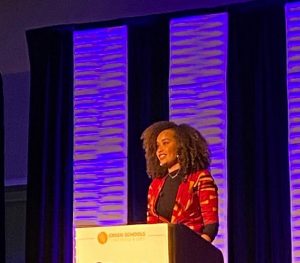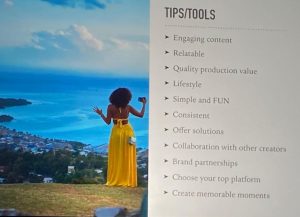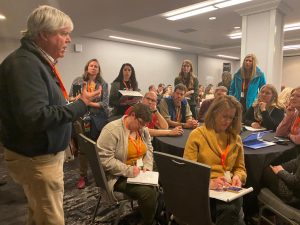
Hats off to the tenth Green Schools Conference and Expo, this year in Portland, Oregon held in early March. I attended and was inspired. With my colleagues from 180.org and the Sierra Club, I and was honored to present EcoMotion’s work with creating and financing carbon-free microgrids that can operate indefinitely in the event of macro-grid failure.
Anisa Heming kicked off the Tenth Annual Green Schools Conference. She’s the director of the Center for Green Schools at the U.S. Green Building Council (USGBC). She stated in opening remarks that green schools are pivotal, they support health and wellness and they prepare students to tackle the most important challenges. She talked about the synthesis heart and innovation. Jenny Seydel, Executive Director of the Green Schools National Network (GSNN) is the movement’s self-proclaimed lead rebel rouser. “Disruption is needed in K-12 schools!” There is a profound need to transform the nation’s 14,000 school districts and 133,000 schools. She passed the conference management to the U.S. Green Building Council (USGBC) in 2016.

Mahesh Ramanujam and Ted Flanigan
The President and CEO of the USGBC, Mahesh Ramanujam, welcomed the crowd. “Together we are transforming schools into healthier places, but also empowering young students.” Mahesh stated that by 2019, USGBC had registered 217 million square feet of LEED-certified schools. In the last 12 months, the USGBC certified nine schools at LEED Platinum. “We are known for our plaques but should be known for remarkable people that are products of these schools.”

Danni Washington of Big Blue and You
Danni Washington spoke next and ignited the crowd! A self-espoused “Jamaican-American girl from Miami,” inspired by her mom who worked for a cruise line and her love of the ocean, Danni became a marine biologist, founded Big Blue and You with her mom, and became a leading science communicator now with her own Fox TV show. She serves as the bridge between academia and the general public, inspiring the world to reconnect with nature. She told her life story, how her career was catalyzed by YouTube, and how to be an effective storyteller with clear narrative, emotional cues, and relatable content. She talked about social media: Instagram, Pinterest, Twitter, Facebook, Snapchat, LinkedIn, and the newest on the block… Tick Tock. She talked about the importance of 30-second messaging, elevator pitch training, and the simple actions that she puts forth that people can easily grasp to take action and get that great feeling of making a positive contribution to the planet.

Two stories from the conference struck me: The first was told by Superintendent Tony Knight of the Oak Park Unified School District in Ventura, California. It’s a K-12 public school district with 4,500 students, among the first of California’s Green Ribbon Schools. I was struck by how the district used recycled shipping containers to build classrooms, which feature indoor-outdoor learning spaces. The district promotes “deep, nature-based learning” with campuses complete with cool rooves, solar energy, battery energy storage, electric vehicle charging, bioswales, organic landscaping, the use of green cleaning and much more. Its food cafeteria program is “plant forward” with only poultry options. Every tree on campus is registered and cared for. Students learn ocean literacy and make a connection with the nearby Channel Islands.

Dr. Tony Knight, Oak Park Unified School District
The Hood River (Oregon) Middle School is lucky to have teacher Michael Becker on its staff. He catalyzed FACS there… Food and Conservation Science. His message was new to me: “You gotta have a kitchen on campus.” Some years ago he went to his school board with notion of “Green STEM (Science, Technology, Engineering, and Math).” They bought it. He hosted a eco-charrette to expand the school and to incorporate a large greenhouse into its design as a living system to grow food and fish, to heat the school thanks to its 14,000 pound seasonal rock battery, and to educate its students. It now produces fresh tomatoes through December. The design also includes solar power, a radiant geothermal heating system, a giant rainwater tank.
Today the school grows much of its food and even sells it in the community. After three years of harvesting food, cooking and serving it, eighth grade students are certified as State of Oregon Food Handlers which prepares them for jobs. Students at the conference talked about their experiences; their excitement about making food for the school board. At one event the students served pizza to 150 people. The commercial kitchen is known as the Conflict Café… teaching students about geography and world conflicts as they study, grow, and cook food from all over the world. FACS does all recycling for entire building. In summer, students’ families take on gardens with summer sales at farmers market allowing kids to earn money in the process.
Thanks to the teachers, administrators, facility directors, suppliers, and specialists of all kinds that are driving the green schools movement. And thanks to the USGBC for convening an inspiring and motivational event.
Healthy Foods in Schools: In related news, two schools in Marin County, California now serve their students 100% organic meals, sustainably sourced and free of genetically modified organisms. Students there now eat fresh, local food year-round thanks to a partnership with the Conscious Kitchen, a project of the environmental education non-profit Turning Green. Its founder noted that the program is not only meetings U.S. Department of Agriculture (USDA) nutritional standards, but “ties the health of our children to the health of our planet.”
The meals in Sausalito are being accompanied by nutritious and gardening education. Tested first in 2013 with 156 students, the program resulted in decreased disciplinary cases and increased attendance. The Conscious Kitchen project consultant notes that, “successfully disrupts the cycle of unhealthy, pre-packaged, heat and serve meals that dominate school kitchens.”

Nutritional experts have long pointed out that food and beverages in schools have a long-term impact on children’s health and well-being. The 2010 Healthy and Hunger Free Kids Act required schools in the United States to update their meal provisions to meet new USDA nutritional standards and to offer more whole-wheat products, fresh fruits and vegetables, and lean proteins for students that receive subsidized school lunches. Berkeley’s Edible Schoolyard Project has long advocated that it is equally important to focus on student education through hands-on lessons taught in classroom, kitchen, and garden. Coupled with education, healthy means are much more likely to be sustained throughout students’ lives.
Franklin Elementary Micro-Recycling: Several weeks ago EcoMotion visited the Franklin Elementary School in Glendale, California where a group of concerned parents – led by my friend Monica Campagna – spearheaded an exemplary effort to address lunch waste. They wanted to eliminate the single-use food trays coming out of the cafeteria, and to sort wastes for composting and recycling. The team sought a donation for a commercial washing machine… and got one. Now stiff plastic trays are reused again and again. We witnessed young student volunteers standing guard making sure that all lunch “waste” is properly recycled, students using oversized tongs on long strings to pull misplaced materials from garbage cans. I call this micro-recycling. I was struck by the simplicity and elegance of share boxes for fruits and unopened yogurt, so that kids that have extra enable kids that are still hungry to eat more. Compost is then distributed to classrooms, each of which have worm bins… every kid learning about vermiculture. We congratulate Monica and her colleagues. Their work is exemplary.
